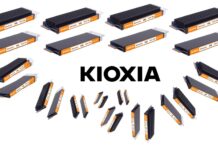IBM now provides direct, switchless access to a Power server’s flash drives, the aim being to enable more cores to access more drives with higher data access bandwidth.
The Power server products are IBM’s proprietary servers and pretty much the last proprietary server CPU technology holdout against the dominant x86 processors and rising Arm and Risc-V processor designs. The processors are used in Power servers and i systems, the old AS/400 which originated in 1988. IBM is updating both its Power and i product lines.

IBM’s VP for Power Product Management, Steve Sibley, writes in a post: “IBM is extending its I/O capabilities with the first known PCIe direct-attached 24-bay NVMe storage drawer in the industry.”
By direct-attach, IBM means there is no PCIe switch or other bump in the wire between the NVMe SSDs and the PCIe lanes leading to the processor cores. The aim is to provide full PCIe lane bandwidth between an NVMe drive and a CPU core that needs to read/write data from/to it. A PCIe switch is often used to aggregate lanes so that each drive only gets a part of the overall bandwidth available.
For example, Supermicro had a 20-drive server with PCIe gen 3 direct attachment in April 2020, the 2029UZ-TN20R25M. This had 80 lanes of PCIe gen 3 bandwidth between the processor and the drives, 4 lanes per drive. IBM is correct in saying it has the first 24-drawer direct-attach PCIe system, but Supermicro did it with 20 drives three years ago.
According to Big Blue, the benefits this brings to Power servers, compared to its current SAS-based Power alternatives, are:
- Lowering $/TB for direct-attached IBM storage by 62 percent,
- Nearly 10X more I/O bandwidth (GBps) and up to 3.7X more I/O operations/sec (IOPS),
- The ability to directly attach up to 1.2 PB of storage (153 TB in a single drawer with support for up to 8 drawers) on a single E1080, and delivering over 85 percent more capacity/Watt,
- Extending the capacity of Flash Cache systems required for large critical database applications,
- Native boot capability for up to 24 partitions.
The E1080 is the top line model in IBM’s range of shipping five Power 10 products:

It has from 8 to 32 PCIe gen 5 adapter slots (8 per node) and supports up to 4 expansion drawers per node, which use PCIe gen 4 adapters. In detail, a system (processor) node supports 6 x PCIe Gen4 x16 or PCIe Gen5 x8 and 2 x PCIe Gen5 x8 I/O low-profile expansion slots per system node (maximum 32 in a 4-node system.)
IBM i product line updates
Technology refreshes for IBM’s i systems portfolio will ship in May, including improvements in IBM Navigator for i, allowing both end users and system administrators to access, manage, and monitor their IBM i environments better. Customers running complex plan data inquiries can realize performance improvements due to the SQL engine’s ability to exploit the Power10’s capabilities.
IBM is providing tape backup for its Power 10 i environments, with:
- New 4-port 12Gbps SAS adapter, at least 2X faster than its current SAS adapters,
- Direct connection to 8Gbps fibre channel tape libraries or standalone tape devices,
- Support for LTO9 tape technology.
Lastly, IBM has partnered with FalconStor Software to bring enterprise-class data protection, disaster recovery, ransomware protection, and cloud migration to Power workloads through FalconStor’s StorSafe Virtual Tape Library (VTL) offering. This VTL provides backup to the cloud and on-premises so users can migrate, backup and restore Power Systems workloads to Power Virtual Server. It works with backup software to reduce capacity requirements and minimizes replication time by removing redundant copies of data with integrated dedupe technology.








